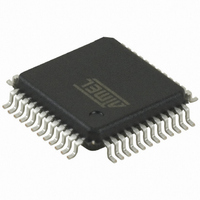AT32UC3B1256-AUR Atmel, AT32UC3B1256-AUR Datasheet - Page 489

AT32UC3B1256-AUR
Manufacturer Part Number
AT32UC3B1256-AUR
Description
MCU AVR32 256K FLASH 48-TQFP
Manufacturer
Atmel
Series
AVR®32 UC3r
Datasheet
1.AT32UC3B164-AUR.pdf
(680 pages)
Specifications of AT32UC3B1256-AUR
Package / Case
48-TQFP, 48-VQFP
Voltage - Supply (vcc/vdd)
1.65 V ~ 1.95 V
Operating Temperature
-40°C ~ 85°C
Speed
60MHz
Number Of I /o
28
Core Processor
AVR
Program Memory Type
FLASH
Ram Size
32K x 8
Program Memory Size
256KB (256K x 8)
Data Converters
A/D 6x10b
Oscillator Type
Internal
Peripherals
Brown-out Detect/Reset, DMA, POR, PWM, WDT
Connectivity
I²C, IrDA, SPI, SSC, UART/USART, USB
Core Size
32-Bit
Lead Free Status / RoHS Status
Lead free / RoHS Compliant
Eeprom Size
-
Available stocks
Company
Part Number
Manufacturer
Quantity
Price
Company:
Part Number:
AT32UC3B1256-AUR
Manufacturer:
OMRON
Quantity:
12 000
- Current page: 489 of 680
- Download datasheet (10Mb)
23.6.1.6
23.6.2
23.6.2.1
32059J–12/2010
Capture Operating Mode
Trigger
Capture registers A and B
A trigger resets the counter and starts the counter clock. Three types of triggers are common to
both modes, and a fourth external trigger is available to each mode.
The following triggers are common to both modes:
• Software Trigger: each channel has a software trigger, available by writing a one to the
• SYNC: each channel has a synchronization signal SYNC. When asserted, this signal has the
• Compare RC Trigger: RC is implemented in each channel and can provide a trigger when the
The channel can also be configured to have an external trigger. In Capture mode, the external
trigger signal can be selected between TIOA and TIOB. In Waveform mode, an external event
can be programmed to be one of the following signals: TIOB, XC0, XC1, or XC2. This external
event can then be programmed to perform a trigger by writing a one to the External Event Trig-
ger Enable bit in CMRn (CMRn.ENETRG).
If an external trigger is used, the duration of the pulses must be longer than the CLK_TC period
in order to be detected.
Regardless of the trigger used, it will be taken into account at the following active edge of the
selected clock. This means that the counter value can be read differently from zero just after a
trigger, especially when a low frequency signal is selected as the clock.
This mode is entered by writing a zero to the CMRn.WAVE bit.
Capture mode allows the TC channel to perform measurements such as pulse timing, fre-
quency, period, duty cycle and phase on TIOA and TIOB signals which are considered as
inputs.
Figure 23-4 on page 491
ture mode.
Registers A and B (RA and RB) are used as capture registers. This means that they can be
loaded with the counter value when a programmable event occurs on the signal TIOA.
The RA Loading Selection field in CMRn (CMRn.LDRA) defines the TIOA edge for the loading of
the RA register, and the RB Loading Selection field in CMRn (CMRn.LDRB) defines the TIOA
edge for the loading of the RB register.
RA is loaded only if it has not been loaded since the last trigger or if RB has been loaded since
the last loading of RA.
RB is loaded only if RA has been loaded since the last trigger or the last loading of RB.
Loading RA or RB before the read of the last value loaded sets the Load Overrun Status bit in
SRn (SRn.LOVRS). In this case, the old value is overwritten.
Software Trigger Command bit in CCRn (CCRn.SWTRG).
same effect as a software trigger. The SYNC signals of all channels are asserted
simultaneously by writing a one to the Synchro Command bit in the BCR register (BCR.SYNC).
counter value matches the RC value if the RC Compare Trigger Enable bit in CMRn
(CMRn.CPCTRG) is written to one.
shows the configuration of the TC channel when programmed in Cap-
AT32UC3B
489
Related parts for AT32UC3B1256-AUR
Image
Part Number
Description
Manufacturer
Datasheet
Request
R

Part Number:
Description:
DEV KIT FOR AVR/AVR32
Manufacturer:
Atmel
Datasheet:

Part Number:
Description:
INTERVAL AND WIPE/WASH WIPER CONTROL IC WITH DELAY
Manufacturer:
ATMEL Corporation
Datasheet:

Part Number:
Description:
Low-Voltage Voice-Switched IC for Hands-Free Operation
Manufacturer:
ATMEL Corporation
Datasheet:

Part Number:
Description:
MONOLITHIC INTEGRATED FEATUREPHONE CIRCUIT
Manufacturer:
ATMEL Corporation
Datasheet:

Part Number:
Description:
AM-FM Receiver IC U4255BM-M
Manufacturer:
ATMEL Corporation
Datasheet:

Part Number:
Description:
Monolithic Integrated Feature Phone Circuit
Manufacturer:
ATMEL Corporation
Datasheet:

Part Number:
Description:
Multistandard Video-IF and Quasi Parallel Sound Processing
Manufacturer:
ATMEL Corporation
Datasheet:

Part Number:
Description:
High-performance EE PLD
Manufacturer:
ATMEL Corporation
Datasheet:

Part Number:
Description:
8-bit Flash Microcontroller
Manufacturer:
ATMEL Corporation
Datasheet:

Part Number:
Description:
2-Wire Serial EEPROM
Manufacturer:
ATMEL Corporation
Datasheet:











